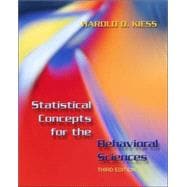
1. Introduction to Statistics.
Studying Statistics: How to Use This Text.
What Is Statistics?
Using Statistics: Three Examples.
Why Are Statistics Necessary?
2. Scientific Research.
What Is Science?
Measurement.
3. Describing Data: Frequency Distributions and Graphs.
Frequency Distributions with Ungrouped Scores.
Grouped Frequency Distributions.
Percentiles and Percentile Ranks.
Presenting Frequency Distributions Graphically.
Graphic Presentation of Qualitative Data.
Shapes of Frequency Distributions.
4. Describing Data: Measures of Central Tendency.
Mode.
Median.
Sample Mean.
Comparing Measures of Central Tendency.
5. Describing Data: Measures of Variability.
Range Measures of Variability.
Measures of Variability About the Sample Mean.
A Comparison of Measures of Variability.
The Choice of Descriptive Statistics.
6. The Normal Distribution, Probability, and Standard Scores.
Normal Distribution.
Standard Normal Distribution.
Probability.
Standard Scores.
7. Using Statistics for Inference and Estimation.
X As a Point Estimator Of.
Estimating the Population Variance and Standard Deviation.
Sampling Distribution of the Mean: Determining the Accuracy of an Estimate.
Estimating the Standard Error of the Mean.
Interval Estimation of the Population Mean.
8. Introduction to Statistical Hypothesis Testing; The z Test and the One-sample t Test.
Statistical Hypothesis Testing.
The One-Sample t Test.
Reporting the Results of the One-Sample t Test.
Important Considerations in Statistical Hypothesis Testing.
Using the t Statistic to Construct Confidence Intervals for the Population Mean.
9. The Basis of Experimentation and Testing for a Difference Between Means.
A Review of the Research Process.
Did the Treatment Have an Effect?
The Need for Statistical Testing.
The t Test For Two Independent Groups.
Power and t.
Measuring the Strength of a Treatment Effect.
Using the t Statistic to Construct Confidence Intervals for the Difference between Two Independent Population Means.
What does A t Test Actually Test?
Statistical and Scientific Significance Revisited.
The Controversy over Statistical Hypothesis Testing.
Reporting the Results of a t Test.
Within-Subjects Designs and the t Test for Related Scores.
10. One-Factor Between-Subjects Analysis of Variance.
An Example One-Factor Multilevel Design.
Between-Groups and Within-Groups Variation.
Obtaining the F-Statistic.
Statistical Hypothesis Testing with F.
Interpreting a Statistically Significant F in a Multilevel Design.
Measuring the Strength of a Treatment Effect.
The Relationship Between t and F.
Reporting the Results of the Analysis of Variance.
11. Two-Factor Between-Subjects Designs and Analysis of Variance.
Information Obtained from a Factorial Design.
Analysis of Variance of a Two-Factor Between-Subjects Design.
Statistical Hypothesis Testing with the Two-Factor Between-Subjects Analysis of Variance.
Interpreting a 2 x 2 Factorial Analysis of Variance.
Reporting the Results of a Factorial Analysis of Variance.
12. One-Factor Within-Subjects Designs and Analysis of Variance.
One-Factor Within-Subjects Analysis of Variance.
Statistical Hypothesis Testing with F.
Reporting the Results of the Analysis of Variance.
Choice of Research Design: Between Subjects or Within Subjects.
13.Correlation.
Scatterplots.
The Pearson Correlation Coeffeicient.
Alternative Formulas for the Pearson Correlation.
Summary of Formulas for r.
Characteristics of r.
Testing the Statistical Significance of the Pearson r.
Reporting the Results of a Correlational Study.
The Spearman Rank-Order Correlation Coefficient.
14. Regression and Prediction.
Linear Relations.
Finding a Linear Regression Line.
Error in Prediction.
15. Nonparametric Statistical Tests.
Analysis of Frequency Data: The Chi-Square Test.
The x2 Test for Goodness of Fit.
Reporting the Results of the Chi-Square Test.
Man-Whitney U Test.
Reporting the Results of the Mann-Whitney U Test.
The Wilcoxon Signed-Ranks Test.
Reporting the Results of the Wilcoxon Signed-Ranks Test.
Using Nonparametric Tests.
Appendix A. Statistical Tables.
Appendix B. Mathematics Review.
Appendix C. Glossary.
Appendix D. Statistical Symbols.
Appendix E. Answers for Computational Problems.
Appendix F. Commonly Used Formulas.
References.
Name Index.
Subject Index.
The New copy of this book will include any supplemental materials advertised. Please check the title of the book to determine if it should include any access cards, study guides, lab manuals, CDs, etc.
The Used, Rental and eBook copies of this book are not guaranteed to include any supplemental materials. Typically, only the book itself is included. This is true even if the title states it includes any access cards, study guides, lab manuals, CDs, etc.